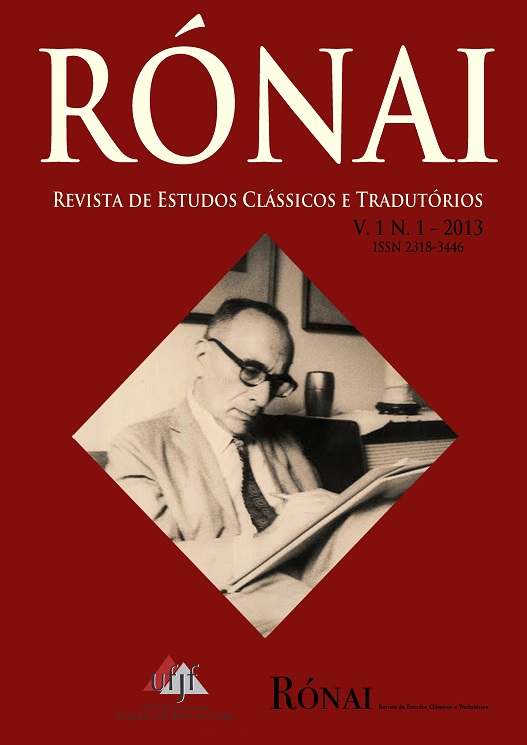Machine translation and translation competence: rethinking intersections
Keywords:
Machine translation, Translation competence, Translation support softwaresAbstract
Since its emergence in the early 1940s, Machine Translation (MA) has been seen in two ways: as a near and present threat, or as a fruitless and obsolete tool. Opposing these images to the notion of translation competence as proposed by the group PACTE, we undertook this article an reticular approach between the emergence of MA, training and qualification of translators and the demands and needs of society and the global translation market, thus seeking to recover some potential contributions that the MA can provide to translation profession.
Downloads
References
ALFARO, Carolina; DIAS, Maria Carmelita Pádua. “Tradução Automática: uma ferramenta de auxílio ao tradutor”. Cadernos de Tradução. n. 1, vol.3. Florianópolis: UFSC/PGET, 1998. p.369-390.
BAKHTIN, Mikhail. A Cultura Popular na Idade Média e no Renascimento: o contexto de François Rabelais. Tradução de Yara Frateschi Vieira. São Paulo: Hucitec; Brasília: Editora UnB, 2008
GONÇALVES, José Luiz Vila Real; MACHADO, Ingrid Trioni Nunes. “Um Panorama do ensino de tradução e a busca da competência do tradutor”. Cadernos de Tradução: vol.1, n.17. Florianopolis: UFSC/PGET, 2006. p.45-69.
HURTADO ALBIR, Amparo. A Aquisição da competência tradutória: aspectos teóricos e didáticos. In PAGANO, Adriana; MAGALHÃES, Célia; ALVES, Fabio. (Org). Competência em Tradução: da cognição ao discurso. Belo Horizonte: Humanitas/ UFMG, 2005.
KOCH, Ingedore Vilaça; ELIAS, Vanda Maria. Ler e Escrever: estratégias de produção textual. São Paulo: Parábola, 2005.
MALEVINI, Graciela; NOGUERA, Inés. “Machine Translation: a fast development, a slow internalization”. Cadernos de Tradução, vol.1, n.4. Florianopolis: UFSC/PGET, 1999.
MARTINS, Márcia Amaral Peixoto (Org). Tradução e multidisciplinaridade. Rio de Janeiro: Lucerna, 1999.
MARTINS, Ronaldo Teixiera. “Tradução Automática”. Revista Todas as Letras, n.2, vl.10. São Paulo: Universidade Presbiteriana Mackenzie, 2008. p.148-169.
NOGUEIRA, Danilo; NOGUEIRA, Vera Marti Cavalcanti. “Por que usar programas de apoio à tradução?”. Cadernos de Tradução. vol.2, n.14. Florianopolis: UFSC/PGET, 1998.
PAGANO, Adriana; MAGALHÃES, Celia Maria; ALVES, Fabio. Competência em tradução: cognição e discurso. Belo Horizonte: Humanitas/UFMG, 2005.
PACTE. “Investigating translation competence: conceptual and methodological issues”. Meta, vol.50, n.2. 2005. p.609-619.
_______. “Building a translation competence model”. In ALVES, Fabio (ed). Triangulating Translation: perspectives in process oriented research. Amsterdam: John Benjamins, 2003. p.44-66.
PYM, Anthony. “Redefinindo a competência tradutória em uma era eletrônica: em defesa de uma abordagem minimalista”. Cadernos de Tradução. Vl.1, n. 28. Florianópolis: PGET/UFSC, 2008.
SNELL-HORNBY, Mary. Translation Studies: an integrated approach. Amsterdan: John Benjamins, 2006 [1995].
SZPAK, Karina Sarto. “Construindo a competência tradutória: avaliando a capacidade estratégia do tradutor em formação”. Anais do VII Congresso Internacional da
ABRALIN. Curitiba, 2011. Disponível em < http://www.abralin.org/ab ralin11_cdrom/artigos/Karina_Szpak.PDF> aceso em 11-01-2013.
VENUTI, Lawrence (ed). The Translation Studies Reader. Londres/Nova York: Routledge, 2000
WEININGER, Marcus. “TM e MT na tradução técnica globalizada – tendências e consequências”. Cadernos de Tradução. Vl.2, n.14. Florianópolis: UFSC/ PGET, 2004. p.243-263.
Downloads
Published
How to Cite
Issue
Section
License
Copyright (c) 2015 Rónai – Revista de Estudos Clássicos e Tradutórios

This work is licensed under a Creative Commons Attribution 4.0 International License.
Copyright
The authors of the published contributions agree with the following items:
1. The authors keep the copyright and convey to the journal the right of first publication, the work being licensed under a Creative Commons Attribution License 4.0 International.
2. The authors are allowed and stimulated to publicize and distribute their work online after the publication in the journal, recognizing first publication in this journal.
3. The authors of the approved works authorize the journal to distribute their content, after publication, for reproduction in content indexes, virtual libraries and similars.
For more information about Creative Commons Attribution License 4.0 International, please, go to: https://creativecommons.org/licenses/by/4.0/deed.en
Editorial exemption
The authors of the published contributions are entirely and exclusively responsible for their contents. Its content does not represent an official position of Rónai - Revista de Estudos Clássicos e Tradutórios neither of Faculdade de Letras da Universidade Federal de Juiz de Fora or their partner institutions.



